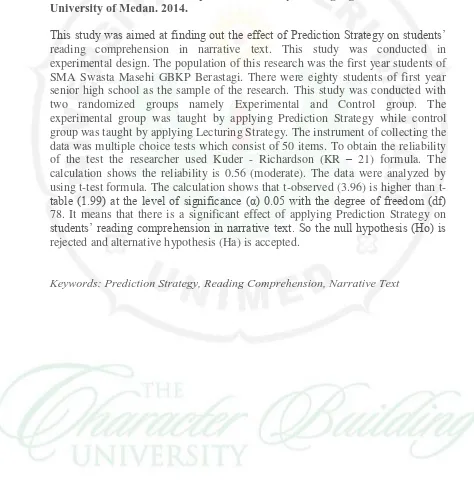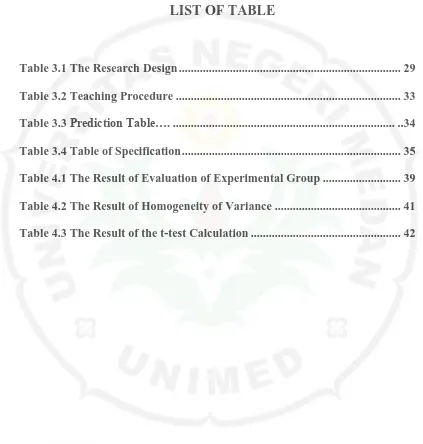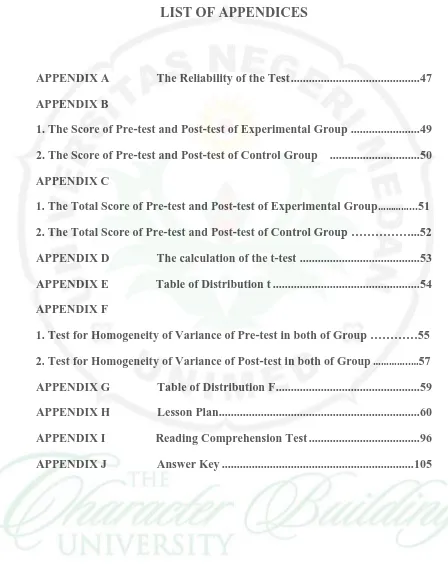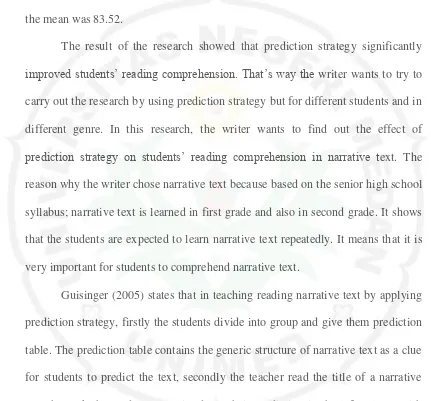THE EFFECT OF PREDICTION STRATEGY
ON STUDENTS’
READING COMPREHENSION
IN NARRATIVE TEXT
A THESIS
Submitted to the English Department Faculty of Languages and Arts UNIMED in partial fulfillment of the requirements for
the Degree of Sarjana Pendidikan
By:
ADI PRANATA SINGARIMBUN
Registration Number.2103121001
ENGLISH AND LITERATURE DEPARTMENT
FACULTY OF LANGUAGES AND ARTS
ABSTRACT
Singarimbun, Adi Pranata. 2103121001 The Effect of Prediction Strategy on Students’ Reading Comprehension in Narrative Text. A Thesis: English Education and Literature Department. Faculty of Languages and Arts. State University of Medan. 2014.
This study was aimed at finding out the effect of Prediction Strategy on students’ reading comprehension in narrative text. This study was conducted in experimental design. The population of this research was the first year students of SMA Swasta Masehi GBKP Berastagi. There were eighty students of first year senior high school as the sample of the research. This study was conducted with two randomized groups namely Experimental and Control group. The experimental group was taught by applying Prediction Strategy while control group was taught by applying Lecturing Strategy. The instrument of collecting the data was multiple choice tests which consist of 50 items. To obtain the reliability of the test the researcher used Kuder - Richardson (KR – 21) formula. The calculation shows the reliability is 0.56 (moderate). The data were analyzed by using test formula. The calculation shows that observed (3.96) is higher than t-table (1.99) at the level of significance (α) 0.05 with the degree of freedom (df) 78. It means that there is a significant effect of applying Prediction Strategy on students’ reading comprehension in narrative text. So the null hypothesis (Ho) is rejected and alternative hypothesis (Ha) is accepted.
ACKNOWLEDGEMENT
First and foremost, the writer would like to express his greatest thanks to the almighty God, Jesus Christ, for the love and great blessing so the writer finally has completed this thesis. This thesis is aimed to fulfill one of the requirements for the degree of Sarjana Pendidikan of the English Department, Faculty of Languages and Arts, The State University of Medan (UNIMED).
The writer realizes that this thesis could not have been completed without prayer, support, guidance, and advice from family, lectures, friend and all people around his who have given great contribution. Therefore, the writer would like to express his sincere gratitude to:
Prof. Dr. Ibnu Hajar Damanik, M.Si., as the Rector of State University
of Medan
Dr. Isda Pramuniati, M.Hum., as the Dean Faculty of Languages and
Arts, Vice Dean I, II, III and all the administrative staff
Prof. Dr. Hj. Sumarsih, M.Pd., as the Head of English Department, and
Dra. Meisuri, M.A., as the Secretary of English Department
Dra. Masitowarni Siregar, M.Ed., as the Head of English Education
study Program
Drs. Willem Saragih, Dipl. Appl, M.Pd., as the writer Thesis Consultant Drs. Bachtiar M.Pd., as the writer Academic Consultant
John Singarimbun and Eliawaty Br Ginting, the writer beloved parents,
and also Albina Singarimbun, Mia Kristian Singarimbun and Ramayana Barus, the writer’s sisters and brother. And also all the writer’s family
Ibu Dra. Keriahen Sinuhaji, the Headmaster of SMA Swasta Masehi
Keluarga Besar PARDIS SELLULAR especially Obet Pandia, for their
kindness, generosity, support, help, and togetherness during the writer lived and worked with him
The writer beloved friends 7 IKAN ( Fadillah Alwi, Fransiska Sipayung,
Putri H.M Sinaga (+), Sinde Elisa Lbn Raja, Syarifah I.T Nst, and
Veronika Napitu) for their help, support, motivation and also for all class
member of Edular Bee (Education Regular B) 2010 for sharing and giving information during the process of lecturing
PPL-T SMA Swasta Masehi GBKP Berastagi 2013 especially for
Ahrasani Purba, Apri Yosiana Ginting, Endang Kacaribu, Johannes
Manalu, Triani Barus, Winda Surbakti for their support and motivation
to accomplish this thesis and also for Sri Ulina Sembiring for her love, care, motivation and prayer.
And for everybody that the writer could not mention one by one who have contribution in finishing this thesis
The writer realize that the content of his thesis is still far from being perfect, but he warmly welcome any constructive suggestion will improve the quality of this thesis. He hopes it would be useful for those who are interested in this field of study.
Medan, December 2014 The Writer
TABLE OF CONTENTS
CHAPTER II: REVIEV OF RELATED LITERATURE ... 7
A. Theoretical Framework ... 7
1. Reading Comprehension ... 7
a. Reading Comprehension as a Process ... 9
b. Factor Affecting Reading Comprehension ... 10
c. Levels of Reading Comprehension ... 12
2. Genre ... 15
3. Narrative Text ... 19
4. Strategy ... 20
a. Prediction Strategy ... 21
1) The Purpose of Prediction Strategy... 23
2) The Advantages of Using Prediction strategy ... 23
3) Teaching Reading By Applying Prediction strategy ... 24
b. Lecturing Strategy... 26
B. Conceptual Framework ... 27
C. Hypothesis ... 28
CHAPTER III: RESEARCH METHODOLOGY ... 29
A. Research Design ... 29
B. Population and Sample ... 29
C. The Instrument of Collecting Data ... 30
D. The Procedure of the Study ... 32
E. Validity and Reliability of the Test ... 34
F. Technique of Data Analysis ... 37
CHAPTER IV: DATA ANALYSIS AND DISCUSSION ... 38
A. Data ... 38
B. Data Analysis ... 40
1. Testing Homogeneity of Variance ... 41
2. Analyzing the Data by Using t-test Formula ... 41
3. Testing Hypothesis ... 42
C. Research Findings ... 43
CHAPTER V: CONCLUSION AND SUGGESTIONS ... 44
A. Conclusions ... 44
B. Suggestions ... 44
Table 3.1 The Research Design ... 29
Table 3.2 Teaching Procedure ... 33
Table 3.3 Prediction Table…. ... ..34
Table 3.4 Table of Specification ... 35
Table 4.1 The Result of Evaluation of Experimental Group ... 39
Table 4.2 The Result of Homogeneity of Variance ... 41
LIST OF APPENDICES
APPENDIX A The Reliability of the Test ... 47
APPENDIX B 1. The Score of Pre-test and Post-test of Experimental Group... 49
2. The Score of Pre-test and Post-test of Control Group ... 50
APPENDIX C 1. The Total Score of Pre-test and Post-test of Experimental Group…………...51
2. The Total Score of Pre-test and Post-test of Control Group ………...52
APPENDIX D The calculation of the t-test ... 53
APPENDIX E Table of Distribution t ... 54
APPENDIX F 1. Test for Homogeneity of Variance of Pre-test in both of Group …………55
2. Test for Homogeneity of Variance of Post-test in both of Group…………..…57
APPENDIX G Table of Distribution F ... 59
APPENDIX H Lesson Plan ... 60
APPENDIX I Reading Comprehension Test ... 96
CHAPTER I
INTRODUCTION
A. The Background of the Study
Reading is one of the important skills to be taught to students because
through reading they can get information from the text that can improve their
knowledge. Reading doesn’t only read the words but also understand the
information from printed text. According to Grabe (2009:9) reading is the ability
to draw meaning from the printed page and interpret this information
appropriately. Reading comprehension is the goal of reading because the purpose
of reading is to grasp meaning from the printed text.
Westwood (2008:31) states that reading comprehension is an active
thinking process through which a reader intentionally constructs meaning to form
a deeper understanding of concepts and information presented in a text. To be able
to accurately understand the text, students need to decode what they read and then
make connection between what they read and what they already know. It involves
the students’ experience and prior knowledge while comprehending the text. It is
clear that reading comprehension is an ability that involves the background
knowledge of the students while they comprehend text.
Nowadays, the expectation on the students’ reading comprehension is
high. But in fact, students’ ability in reading is a significant problem in schools.
Based on the writer’s experience when he took a teaching practice program in
SMA Sw Masehi Berastagi, he found that almost all students especially grade ten,
get score below minimum criterion (KKM) that is 70. It is difficult for students to
comprehend the text because they have problem in understanding the words and
sentences in the text. They do not know how to activate and develop their prior
knowledge when reading a text. And also the reading method that is used was not
effective. In reading class, the students usually read a text that is given by the
teacher silently or loudly, and then students have to answer the question based on
the reading material. Consequently, the reading lesson becomes monotonous and
boring that’s why the students were not interested in reading and sometimes they
were sleepy and makes noise in the classroom.
Dealing with the fact previously mentioned, the writer wants to try to carry
out a research in teaching reading. In order to make teaching and learning process
interesting and effective, teachers need a good technique, method or strategy in
teaching reading. By using an appropriate technique, method, or strategy it is
hoped that students’ achievement on the reading comprehension will improve.
The strategy that can be applied in improving students’ achievement in reading is
Prediction strategy.
Guisinger (2005) states that predicting is a strategy in which readers think
about what they are going to read based on clues from the reading. It is an
ongoing process that actively engages the reader in two ways: 1) the reader’s mind
is a jump ahead, trying to figure out what is coming next or making new
predictions, 2) while at the same time the reader is revising and refining the old
Making predictions activates students' prior knowledge about the text and
helps them make connections between new information and what they already
know. By making predictions about the text before, during, and after reading,
students use what they already know as well as what they suppose might happen
to make connections to the text. According to Block et.al in Zygouris (2004:1)
predicting involves previewing the text to anticipate what will happen next. By
making prediction, readers are using the following processes: prior knowledge,
thinking on a literal and inferential level, adding to their knowledge base, linking
efferent and affective thinking processes, making connection, and filling the gaps
in the author’s writing. Making prediction while reading a text, keeps the mind
actively focused on the author’s meaning and provide the reader with motivation
and a purpose for reading.
There have been some previous researches dealing with Prediction
Strategy. Herdiana (2012) conducted a research with the title Teaching Reading
Skill Using Predicting Strategy at The First Grade Students of MA Yanuris
Ciranjang Cianjur. The result of her research indicated that Prediction Strategy
improved students’ reading comprehension. The improvement can be seen from
students’ reading score which fulfilled the minimum standard of learning success.
The mean score of pre-test was 65.68 and the mean score of post-test was 77.95.
Another researcher Perangin-angin (2013) conducted a research with the title
Improving Students’ Reading Comprehension in Descriptive text by Applying
Prediction Strategy at the first grade students of SMA Negeri 1 Kisaran. Based on
test the mean was 53.41, in the cycle I test the mean was 67.52, and in the cycle II
the mean was 83.52.
The result of the research showed that prediction strategy significantly
improved students’ reading comprehension. That’s way the writer wants to try to
carry out the research by using prediction strategy but for different students and in
different genre. In this research, the writer wants to find out the effect of
prediction strategy on students’ reading comprehension in narrative text. The
reason why the writer chose narrative text because based on the senior high school
syllabus; narrative text is learned in first grade and also in second grade. It shows
that the students are expected to learn narrative text repeatedly. It means that it is
very important for students to comprehend narrative text.
Guisinger (2005) states that in teaching reading narrative text by applying
prediction strategy, firstly the students divide into group and give them prediction
table. The prediction table contains the generic structure of narrative text as a clue
for students to predict the text, secondly the teacher read the title of a narrative
text then ask the students to write down their prediction in the left column with
basic question of who, where, when, what, and how, thirdly giving the text and
ask the students to write down in the middle column what fact they find that
support or refute their prediction. In order to do this, they need to skim the generic
structure of a text. Finally after reading whole the text they can fill in the right
column confirming or refining their prediction using the information they found in
In short, the writer simplifies that to overcome the problem of teaching
reading, especially in comprehending the text, the teacher needs to apply
prediction strategy. In which, it can be help students to activate their experience
and prior knowledge while comprehending a text. If the students’ experience or
prior knowledge have been activated they will be easier to interact with the text.
They will quickly understand what the text about because they have prior
knowledge about it. Applying prediction strategy is expected to solve the problem
and to bring good improvement in students’ reading achievement.
B. The Problem of the Study
Based on the previous discussion in the background of the study, the
problem of the study is formulated as the following: “Is there any significant
effect of applying Prediction Strategy on the students’ reading comprehension in
Narrative text?”
C. The Scope of the study
In this research, the focus of the investigation is limited to the effect of
Prediction Strategy on the students’ reading comprehension. The genre is limited
to Narrative text. There are four levels of reading comprehension, namely: literal
comprehension, interpretative comprehension, critical comprehension and creative
comprehension. In this study, not only limit to literal comprehension and
interpretative comprehension but also for critical comprehension and creative
D. The Objective of the Study
In relation to the problem, the objective of the study is to find out whether
Prediction Strategy significantly affects the students’ reading comprehension in
Narrative text.
E. The Significance of the Study
The results of the study are expected to be useful for:
a. The English teacher to provide his/her as alternative method to
improve his/her methods in teaching reading.
b. Other researchers who are interested in conducting further study to
CHAPTER V
CONCLUSIONS AND SUGGESTIONS
A. Conclusions
Based on the data analysis and discussion, the researcher concludes that
there is a significant effect of applying Prediction Strategy on students’ reading
comprehension in narrative text. Teaching reading comprehension especially in
narrative text by applying Prediction Strategy gives better result than teaching
reading comprehension by applying lecturing strategy. This supported by the data
analysis result in which t-observed (3.96) is higher than t-table (1.99) at the
significant level of (0.05).
B. Suggestions
Based on the conclusion above, the researcher gives suggestions as
follows:
1. The English teachers are suggested to use Prediction Strategy as a new
strategy in teaching reading process especially in narrative text because
this strategy is proved effective to improve the students’ ability in
reading comprehension.
2. Other researchers who may apply Prediction Strategy for further
research. It is suggested for them to manage the sufficient time when
REFERENCES
Afflerbach, P. 1990. The Influence of Prior Knowledge and Text Genre on
Readers’ Prediction Strategies. Journal of Reading Behavior. Vol.XXII. No.2. Available in http://jlr.sagepub.com. Accessed on April 26th 2014
Alderson, J.C. 2000. Assessing Reading. UK: Cambridge University press
Ary,D., Jacos,L.C. and Razavieh, A. 2002. Introduction to Research in Education. Belmont: Wadsworth/Thomson Learning.
Best, J.W. and Khan, J.V. 2002. Research in Education 7th. New Delhi : Prentice Hall.
Brown, D. 2001. Principle Language and Teaching. New York: Longman
Brown, D. 2004. Language Assessment, Principle and Classroom Practices. New York : Longman
Burns, Roe and Rose. 1984. Teaching Reading in Today’s Elementary Schools. Boston: Houghton Mifflin Company
Grabe, W., and Stoller, F.L. 2009. Teaching and Researching Reading. Great Britain: Longman
Guisinger, P. 2005. Improving Learning in Ohio:Predicting. Available in http://www.ohiorc.org/adlit/strategy/strategy_each.aspx?id=000009. Accessed on April 7th 2014
Harmer, J. 1998. How to Teach English, An Introduction to the Practice of English Language Teaching. London: Longman
Herdiana, H. 2012. Teaching Reading skill Using Predicting Strategy at The first grade Students of MA Yanuris Ciranjang Cianjur. Bandung: STKIP
Kjhatzi. 2009. Making Prediction. Available in http://www.slideshare.net. Accessed on April 27th 2014
Lyutania, T. 2011. Reading Logs: Integrating Extensive Reading with Writing Task. English Teaching Forum Journal 2011. Vol. 49, No.1. Available in http://americanenglish.state.gov/resourches/english-teaching-forum-2012-volume-50-number-4. Accessed on April 22nd 2014
Strategies_Oxford_GALA_2003_LANGUAGE_LEARNING_STYLES_ AND_STRATEGIES_AN_OVERVIEW. Accessed on April 27th 2014
Pardiyono. 2007. Pasti Bisa: Teaching Genre Based Writing. Yogyakarta: Andi
Prangin-angin, H. 2013. Improving Students’ Reading Comprehension in
Descriptive Text By Applying Prediction Strategy. Medan: UNIMED
Smith, R.J and Johnson, D.D. 1980. Teaching Children to Read. Canada: Library of Congres Catalog Card.
Snow, Catherine. 2002. Reading for Understanding. US: RUN
Westwood, P.S. 2001. Reading and Learning Difficulties. Australia: ACER Press
Westwood, P.S. 2008. What Teacher Need to Know about Reading and Writing Difficulties. Australia: ACER Press
Zygouris-Coe,Vicky and Glass, Catherin. 2004. FOR PD’s Reading Strategy of the Month: Prediction Wheel. Available in http://forpd.ucf/strategies/ stratWhell. html. Accessed on April 7th 2014



